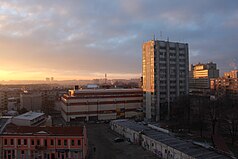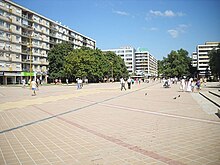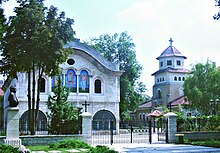
Dobruja or Dobrudja is a geographical and historical region in Southeastern Europe that has been divided since the 19th century between the territories of Bulgaria and Romania. It is situated between the lower Danube River and the Black Sea, and includes the Danube Delta, the Romanian coast, and the northernmost part of the Bulgarian coast. The territory of Dobruja is made up of Northern Dobruja, which is a part of Romania, and Southern Dobruja, which is a part of Bulgaria.

Southern Dobruja, South Dobruja, or Quadrilateral is an area of north-eastern Bulgaria comprising Dobrich and Silistra provinces, part of the historical region of Dobruja. It has an area of 7,412 square km and a population of 358,000.

Kazanlak (Bulgarian: Казанлък, known as Seuthopolis in ancient times, is a town in Stara Zagora Province, Bulgaria. It is located in the middle of the plain of the same name, at the foot of the Balkan mountain range, at the eastern end of the Rose Valley. It is the administrative centre of the homonymous Kazanlak Municipality.

Sliven is the eighth-largest city in Bulgaria and the administrative and industrial centre of Sliven Province and municipality in Northern Thrace. It is situated in the Sliven Valley at the foothills of the Balkan Mountains.

Haskovo is a city in the region of Northern Thrace in southern Bulgaria and the administrative centre of the Haskovo Province, not far from the borders with Greece and Turkey. According to Operative Program Regional Development of Bulgaria, the urban area of Haskovo is the seventh largest in Bulgaria and has a population of 184,731 inhabitants. Haskovo has a population of 64,564 as of 2022, making it Bulgaria's 12th largest city.

Pleven is the seventh most populous city in Bulgaria. Located in the northern part of the country, it is the administrative centre of Pleven Province, as well as of the subordinate Pleven municipality. It is the biggest economic center in Northwestern Bulgaria. At the 2021 census its population was 89,823.

Gotse Delchev, is a town in Gotse Delchev Municipality in Blagoevgrad Province of Bulgaria.

Razlog is a town and ski resort in Razlog Municipality, Blagoevgrad Province in southwestern Bulgaria. It is situated in the Razlog Valley and was first mentioned during the reign of Byzantine emperor Basil II.

Balchik is a town and seaside resort on the Bulgarian Black Sea Coast in the Southern Dobruja area of northeastern Bulgaria. It is in Dobrich Province, 35 km southeast of Dobrich and 42 km northeast of Varna. It sprawls scenically along hilly terraces descending from the Dobruja plateau to the sea, and is often called "The White City" because of its white cliffs.
Breznik is a town in western Bulgaria, 50 km away from Sofia. It is located in Pernik Province and is close to the towns of Bankya and Pernik. Villages in the municipality include Begunovtsi, Dushintsi, and Velkovtsi.

Karnobat is a town in the Burgas Province, Southeastern Bulgaria. It is the administrative centre of the homonymous Karnobat Municipality. According to the 2021 census, the town had a population of 16,483.

Pazardzhik is a city situated along the banks of the Maritsa river, southern Bulgaria. It is the centre of Pazardzhik Province and Pazardzhik Municipality. It is located in the Upper Thracian Plain and in the Pazardzhik-Plovdiv Field, a subregion of the plains. It is west of Plovdiv, about 37 kilometres (23 mi), 112 kilometres (70 mi) southeastern of Sofia and 288 kilometres (179 mi) from Burgas. The population is 55,220, as it has been growing around from the end of the 19th century to the end of the 20th century. The city reached its highest milestone, exceeding 80,000. Due to poor economic performance in Bulgaria during the 1990s and early 2000s, emigration of Bulgarians began, which affected Pazardzhik as well.

Kavarna is a Black Sea coastal town and seaside resort in the Dobruja region of northeastern Bulgaria. It lies 42 kilometres northeast of Varna, 43 km (27 mi) from Dobrich, and 43 km (27 mi) south of the border with Romania. It is the principal town of Kavarna Municipality, part of Dobrich Province. As of December 2009, the town had a population of 11,397. A little yacht port, a fishing base, a spacious beach and a resort complex exist in the town. The landmark Cape Kaliakra is located a few kilometers to the east, as is the tiny beachfront resort of Rusalka. Three 18-hole golf courses with villa communities and marinas are being developed nearby, two of the courses are designed by Gary Player and one by Ian Woosnam.

Bajina Bašta is a town and municipality located in the Zlatibor District of western Serbia. The town lies in the valley of the Drina river at the eastern edge of Tara National Park.

The Despotate of Dobruja or Principality of Karvuna was a 14th-century quasi-independent Bulgarian polity in the region of modern Dobruja, that split off from the Second Bulgarian Empire under the influence of the Byzantine Empire. The Despotate of Dobruja existed from 1356 to 1411.

Shabla is a town and seaside resort in northeastern Bulgaria, administrative centre of the Shabla Municipality part of Dobrich Province. Shabla municipality includes the following villages: Bojanovo, Chernomortsi, Durankulak, Ezerets, Gorichane, Gorun, Granichar, Krapets, Prolez, Smin, Staevtsi, Tvarditsa, Tyulenovo, Vaklino, and Zahari Stoyanovo. As of December 2009, the town itself had a population of 3,586 inhabitants. It is situated on the Bulgarian Black Sea Coast in the vicinity of the salt-water Lake Shabla and Bulgaria's easternmost point, Cape Shabla.

Dobrotitsa was a Bulgarian noble, ruler of the de facto independent Principality of Karvuna and the Kaliakra fortress from 1354 to 1379–1386.
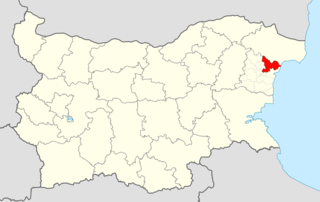
Aksakovo Municipality is a municipality (obshtina) in Varna Province, Northeastern Bulgaria, located near the Bulgarian Black Sea Coast. It is named after its administrative centre – the town of Aksakovo.
Dağpazarı is a neighbourhood in the municipality and district of Mut, Mersin Province, Turkey. Its population is 245 (2022). Situated in the Taurus Mountains, northeast of Mut, the road distance to Mut is about 35 kilometres (22 mi) and to Mersin is 195 kilometres (121 mi). Dağpazarı is also a yayla (resort) of Mut residents and in summers the population may increase.
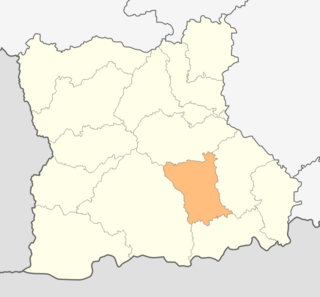
Gotse Delchev Municipality is a municipality in Blagoevgrad Province in Bulgaria. It is situated in the southwestern part of Bulgaria in the valley of Mesta river and the surrounding parts of Pirin and Rhodope mountains, bordering with Sandanski Municipality to the west, Bansko Municipality to the north, Garmen Municipality to the east and Hadzhidimovo Municipality to the south.
